Zuchon Dog Breed – Temperament, Diet and Training
The playful, yet docile Zuchon is a little designer dog that anyone will fall in love with immediately.
This little fellow has not only attractive looks but also an engaging personality. Compliant and easy to train, it makes a loving, faithful friend for life. Here’s everything you will want to know about its physical, mental, emotional, and social needs.
What Is A Zuchon?
A quintessential designer dog, the Zuchon is a blend of two dogs, the Shih Tzu and the Bichon Frise. The American Kennel Club hasn’t acknowledged it as a pure breed.
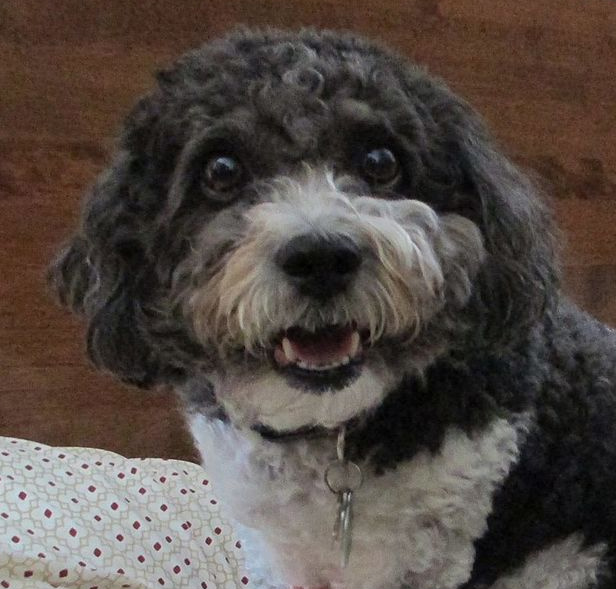
This hypoallergenic dog doesn’t shed but requires constant grooming. As a crossbreed, it has hybrid vigour. As such, first generation Zuchons have better health than purebred dogs.
Zuchon History
The Teddy Bear Dog, like other designer dogs, became popular in the 1990s. During this decade, breeders started cross-breeding the Chinese Shih Tzu with the Mediterranean Bichon Frise. We do not know much about is history, but we do know a lot about its parents’.
1. The Shih Tzu
The Shih Tzu has a genetic relationship with the wolf. Another theory is that it originated in China, where breeders called it the Lion Dog.
Some theorists say that it is a cross between the Lhasa Apso and the Pekingese. The Lhasa Apso was a feature in Chinese paintings.
Understandably, the Chinese valued the little Shih Tzus they bred and refused to give any puppies away.
Breeders first began importing the dogs into Europe in 1930. The first Shih Tzus arrived in Norway and England. The Shih Tzu Club of Britain developed a standard for the breed in 1935. These small dogs became accepted throughout Europe. The UK Kennel Club officiated it in 1940 when it gained eligibility for Challenge Certificates. The American Kennel Club recognised it in the 1950s.
All the kennel clubs in the English-speaking world now recognise the Shih Tzu. It ranked as the 13th most popular breed in 2013.
2. The Bichon Frise
The Zuchon’s other parent is the gentle Bichon Frise. It was initially a Spanish sailing dog.
Spanish Sailors used Bichons as barter as they moved around the world. They introduced the dogs to people on the Canary Islands of Tenerife. Italian sailors discovered then later and brought them back to Europe. They became the favourites of Italian nobility and had a talent for retrieving.
The Bichon had success in France as well. It had overwhelming popularity in the courts of Henry III and Napoleon III. Commoners in France received it warmly.
The Societe Centrale Canine, the national Kennel Club of France, recognised it as a pure breed in 1933. It gained recognition going to the success of The Adventures of Tintin by Belgian author Herge.
The Bichon had two names at the time – Tenerife and Bichon. The president of the Federation Cynologique Internationale suggested a new name, Bichon Frise, because of its curly hair. The Societe Centrale Canine listed the dog in its stud book.
The Bichon then travelled to the United States. The first litter was born on the US mainland in 1956. Breeders later acquired the dog for further development.
The Bichon then began participating in dog shows. It appeared for the first time in the non-sporting group at the American Kennel Club show in 1973. JR, a Bichon, when the Best in Show title in 2001. The Bichon became the AKC’s most popular breed in 2013.
Buying a teddy bear puppy
You probably looked through many Google images before deciding that the Zuchon is the right dog for you. Don’t run to the nearest pet store because there are few things you must know about it first.
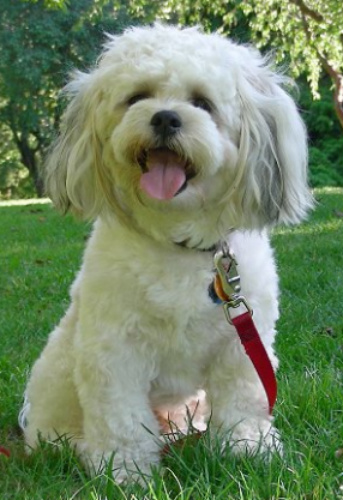
1. The Zuchon is needy
This little teddy bear needs lots of love and attention. It also has a propensity for separation anxiety. Being a mix of the Shih Tzu and Bichon makes it a devoted companion dog. It hates it when its owner leaves home. Find ways to occupy it while you are at work.
2. Teddy bear dogs need to exercise
There’s a reason the Zuchon earned the name the name Teddy Bear. It’s very round.
This little dog needs a lot of physical stimulation and exercise, especially during its puppyhood. Like both his parents, it’s a somewhat sedentary dog. Nothing will make it happier than when you roll it around the floor or play Chase with it in the living room.
3. Potty training will take some time
The Zuchon is an intelligent but somewhat stubborn dog. You may not be able to get it to do what you want at once. Prepare yourself for long sessions of house training. Zuchon puppies need at least two months to learn to ease themselves on newspapers consistently. That said, it will happen with effort.
4. Teddy Puppies chew
Your puppy’s new teeth will start to emerge when it’s about four months old. You’ll have to invest in chew toys before your home looks like a disaster zone.
Vets recommend frozen knuckle bones that owners can freeze after their dogs chew them. These can occupy the dog for up to 30 minutes a day.and are available at supermarket meat counters,
The best chew toys are safe, organic toys, bully sticks, and anything that takes a long time for the dog to finish. They last for a long time and will occupy the dog for hours,
5. Buy a retractable dog leash
You will probably need a retractable leash if you live in the city.
Your teddy bear puppy won’t be a steady right now at first, so you will need to keep it in check. It will stumble when you first bring it out but will gain confidence one day and hop onto the road. A retractable leash is a wise idea.
Furthermore, teddy bears are renowned runners. You will need a retractable leash for all the running it wants to do. Get one for a mid-sized dog.
6. Don’t be afraid of hurting your dog
Every dog owner fears to hurt his puppy while housebreaking it. Your teddy bear pub is more resilient than you think, so don’t be afraid to put it through the motions. And you’re not likely to be extreme.
Zuchon Appearance
There is a reason the Zuchon got the name teddy bear. It looks like a child’s favourite soft toy. Because it is a cross breed, its appearance varies.
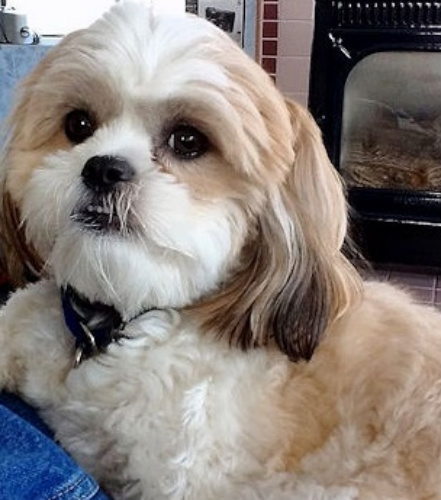
A Shih Tzu has a flat face, floppy ears and a mixed coat of black, tan, brown and white hairs. The Bichon is sturdy, with white fur and floppy ears.
A fully grown teddy bear dog weighs between 5 and 15 pounds. This medium-sized dog stands between six and 12 inches.
Its fur is either silky or curly, depending on whether it takes after the Shih Tzu or Bichon. This dog has either brown or hazel eyes. Its nose is black.
The teddy bears head is slightly rounded, and it has a flat muzzle. The Shih Tzu is brachycephalic, which means that the Zuchon will have a flat face. Like it’s Shih Tzu parent, it may have a black mask.
This dog has a confident look. Its sturdy tail curls over its back. Like its parents, it has floppy ears. Though small-sized, it has a muscular body.
Frequently Asked Questions About Housebreaking Zuchons
Potty training a puppy is a challenge. Zuchon puppies, in particular, are a task to train because they have a stubborn streak, which one can attribute to their Shih Tzu parentage. Potty training is a lot of work but is achievable with effort.
1. Why do I need to define my puppy’s toileting area?
To get your puppy to ease itself in the right area, you must first define it. Lay out newspapers where you want your teddy bear puppy to relieve itself and leave it there. As it becomes accustomed to the smell of the area, it will begin to ease itself there.
Then, begin to narrow the area to the exact spot you want it to use. Your Zuchon will understand that the place is it’s ‘restroom’.
2. Is crate training appropriate?
Some people may not enjoy the idea of putting an animal in a crate because it seems abusive and confining. But it’s a useful training tool.
A crate can serve as a haven for your pet. You will need it for safety reasons during long journeys or trips to the vet. Besides, it can be your dog’s space, a place it can go to when it feels that it needs to be on it own.
A crate is also a necessary potty training mechanism. To use it this way, make sure that it’s the right size. Your dog should be able to turn around, sit, and lie down. It may start to relieve itself in a corner if the crate’s too big. Your dog will let you know when it needs to go. You can tell that it does when it starts to move about restlessly.
3. Are there potties for dogs?
Yes, in case you’re not aware, there are potties for dogs. You can use these to define the area where you want your dog to relieve itself.
4. Create a routine
Also, set up a routine for your puppy.
The first few nights with a new pup are quite trying. Having been separated from its littermates, it will feel lonely. Put it in a crate with the door opening to a Rubbermaid that fits snugly. Provide the food and water source.
Continue this routine until the new puppy sleeps through the night. You should be able to close the kennel door eventually. The puppy will also start to ease itself indoors.
Then, begin to bring your puppy outdoors. Do this every half an hour at first, then every hour. Finally, bring it out twice a day.
As a guideline, a three to a four-month-old puppy can stay in a kennel for about 3 hours. 4 to 6-month-old puppies can remain crated for about 4 hours. Older puppies should be in its doghouse for no more than 6 hours.
The Zuchon Temperament
The white and jaunty Bichon Frise is the perfect companion. It’s peaceful with other pets and people, but can be shy. Hence, socialisation is necessary.
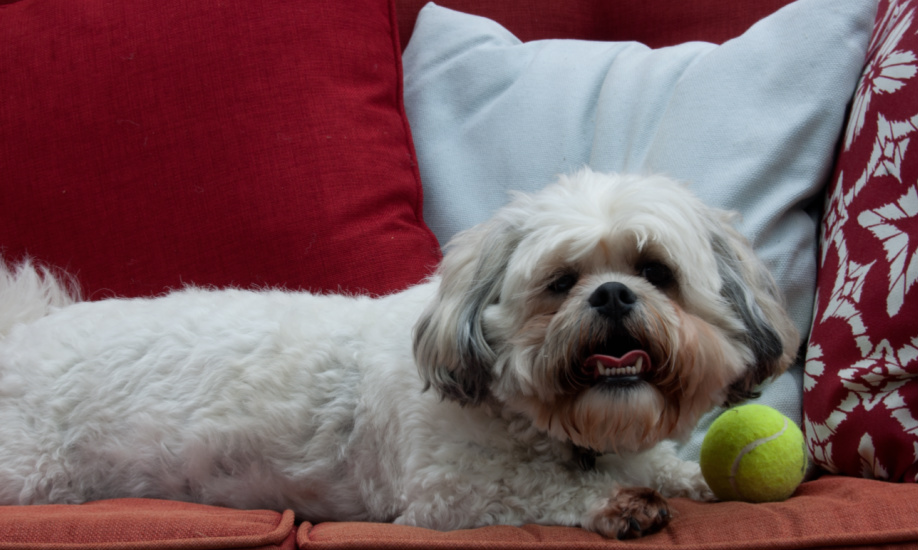
The unassuming Shi Tzu will be your best friend. It loves nothing better than to follow it’s owner from room to room.
Like both its parents, the Zuchon will show these behaviours. It is a quiet, yet playful dog. It will protect its loved ones in whichever way it can.
Hence, without a doubt, the Teddy Bear dog has a great personality that has become its trademark. It’s gentle, well-mannered, lively, and playful. Socialisation will make it a pet that your family will love.
Furthermore, social interaction is necessary for the teddy bear. It’s shy, like both its parents. Bring it to dog parks where it can meet other people and dogs. Also, make sure that it gets regular walks. This time is when they have a chance to interact with people and pets.
Like its Shih Tzu parent, it’s a lovable dog which needs constant cuddling. Zuchons are devoted to their families but made a lot of attention. They are a little insecure and cannot be left alone for extended periods.
Teddy bears are excellent watchdogs. They will sound an alert when they see a stranger. You will feel relieved to know they don’t bark excessively.
They are excellent with other pets and children, but owing to their small size, need supervision so that they are not hurt. One drop is catastrophic for puppies.
The teddy bear can live a somewhat sedentary life. However, it still needs constant exercise and opportunities to play. Find ways to help it occupy itself around the home. Give it chew toys and bring it to dog runs.
You can avoid bringing a dog with negative traits into your home. If you are concerned about excessive barking ( see the section on managing annoying behaviours), choose an adult teddy bear dog. An adult’s negative traits are readily observable.
If you wish to raise a teddy bear from puppyhood, choose the right breeder and puppy. We have advice on this in another section.
Finally, obedience training can help to rein in a dog’s bad habits. Read the section in this article on the basic commands every teddy bear should understand. You will find that the teddy bear dog is easy to train because it’s eager to please. You’ll also discover its extraordinary intelligence.
The Zuchon’s Health
Crossbred dogs are supposed to be healthier than their parents. However, both teddy bear parents have a long history of disorders. Hence, the teddy bear is prone to a host of inherited diseases.
1. Atopic dermatitis
This skin disorder causes itch and inflammation. The disease has links with allergies. It has many causes, including dust mites, dander, and mould. A rash will appear around the eyes, ears, wrists, feet, and underarms.
It happens when the feet or ears start to itch. The Bichon is prone to this disease, and it may show signs of it from as young as five months. The teddy bear might inherit it as a result.
2. Brachycephalic Airway Syndrome
This disease is most common among dogs with flat faces. (pugs, Shih Tzus, Sharpeis, and Bulldogs). Their pushed-in masks shorten their airways., making it difficult for them to breathe. They may also have elongated soft palates or tongues, which may block their airways,
Zuchons may inherit this trait from their Shih Tzu parents. To manage the Brachycephalic Airway Syndrome, make sure that you hose your dog regularly when the weather is hot. Never leave it alone in a hot car with the windows rolled up. Also, carry a portable fan with you if you can.
3. Cushing’s Disease
A dog may have rising corticoid levels because it has tumours n the brain which secretes hormones. The symptoms of this condition include weight gain, skin thinning, hair loss, and perpetual thirst. A dog may experience additional symptoms, such as fat pads in the neck area, muscle weakness, and bruising.
The most common cause of Cushings Disease is tumours that block the pituitary gland. These make the thyroid overactive and secrete hormones. And renal Cushing’s disease may also come about because of tumours in the adrenal glands, which rest on top of the kidneys.
Getting rid of the offending tumours usually solves the problem, but preexisting conditions may complicate the removal process.
4. Dry Eye
Dry eyes in dogs usually come about because of the destruction of the tear glands. The eyes cannot produce tears, which causes dryness, irritation, and infection.
Dogs with dry eyes may paw at them repeatedly. Their eyes may become red and swell as well. The cornea will have a dull, lacklustre look. Discharge may accumulate on the outside of the eye, and the eyelid may protrude, causing a phenomenon known as Cherry Eye. The dog may also become sensitive to light and begin to squint. It may even blink repeatedly and have impaired vision. Vets may recommend prescription drugs or surgery to treat the condition.
5. Patellar Luxation
Patellar luxation, also known as hindlimb lameness, is due to the kneecap dislocating when the dog walks or runs. Affected dogs exhibit an occasional three-legged gait, but often don’t experience pain. Many require surgery to prevent joint diseases.
Curbing annoying teddy bear dog behaviours
All dogs are prone to undesirable behaviours. The teddy bear dog is no exception. Here are five responses but he may display, and some suggested ways of managing them.
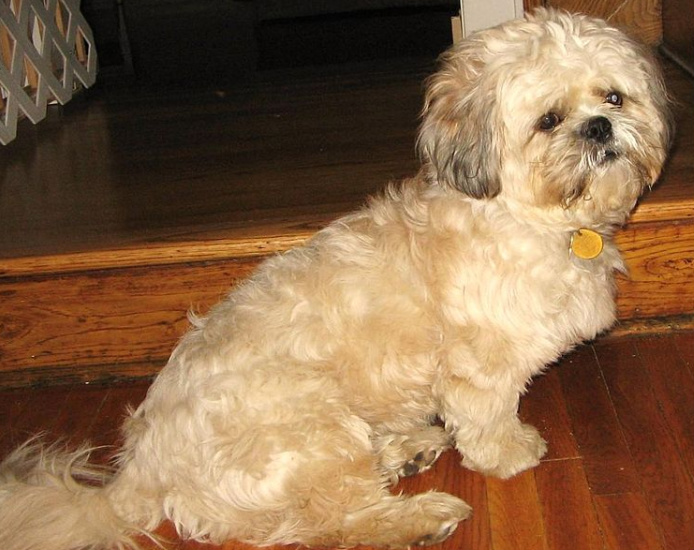
1. Eating trash
Your teddy bear may pick up trash from the floor and ingest it. Alternatively, it may hang around your trash can and forage for scraps.
To prevent this behaviour, hide the trash can. You can also teach your dog the ‘leave it’ command.
2. Nipping
This behaviour may seem adorable when a puppy does it, but will eventually become annoying. If your dog turns aggressive when it nips, it may even be dangerous.
To counter this behaviour, let your hand go limp whenever your pup nips you. Let out a yelp. Your puppy will understand that it’s inflicting pain and stop the nipping.
3. Humping
This behaviour is embarrassing, so you must trace its root. A humping dog could have a medical problem. It may also hump to seek attention.
Don’t scold your dog when it humps. Talk about its behaviour with your veterinarian. When you spot your dog humping, distract it and redirect it with a command it understands.
4. Jumping
No dog likes to be left alone. Your dog probably jumps on you when you enter the door because it misses you.
That said, you shouldn’t condone the behaviour. Ignore your dog when it jumps on you. Giving it attention straight away will reinforce the behaviour. Pat it only after it calms down.
5. Having endless energy
Teddy bears can be Duracell batteries that go on and on. It probably only does so because it’s unoccupied. Your Zuchon dog may behave this way if you have do not exercise it. Make sure that you take it out for daily walks or trips to the dog run.
6. Barging through the door
Does your dog rush out of the door before you? It probably doesn’t know who’s boss.
Show your dog that you will not tolerate this behaviour. Teach it the ‘stay’ command. Make sure that it comes through the door only after you do.
7. Pulling
There’s nothing more frustrating than a dog dragging you everywhere. Pulling makes walks very unpleasant. Furthermore, you will feel embarrassed when someone else tries to walk it.
To counter pulling, teach the ‘heel’ command. Always walk with the dog’s leash across your body. When your dog pulls you, turn at a 90-degree angle and stop. The resistance will make it aware that it should not drag you around.
Grooming your teddy bear dog
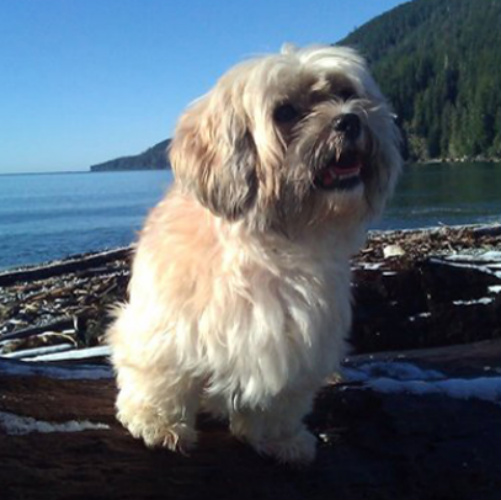
The Zuchon’s silky coat is easy to groom, but you must do so regularly. Here’s how to maintain this cute little dog’s appearance.
1. Bathing
Bathe your teddy bear once a month to maintain its hygiene. Massage a dog-safe shampoo into its coat. Take care not to tangle its fur. Rinse the shampoo off, then apply a conditioner. To prevent tangles, brush the dog’s hair before blow drying it.
2. Brushing
You should brush your teddy bear’s hair daily. It has long hair which mats quickly, but this will not happen if you brush it out every day without fail. Remember to brush its tail as well.
3. The eyes
Trim the hair around your dog’s eyes short. Trimming prevents the hair from falling over its eyes and irritating them.
4. Cleaning the ears
Clean the inside of your teddy bear’s ears with a Q-tip dipped in an ear solution. Remember that a dog’s ear canal is long, so putting the Q-tip in too far may injure it. Clean what’s visible.
5. Nail trimming
Clip your dog’s nails once weekly. Some dogs don’t like having their nails cut. To get yours used to the process, massage its paw first. Only start cutting when the dog is ready to prevent accidents. Don’t cut into the quick, which is the pinkish flesh underneath the nail.
Frequently Asked Questions about a Zuchon Dog’s Nutrition Needs
New owners usually have a whole list of burning questions to ask about their puppies nutrition. Here are a few questions you may have about feeding your new teddy bear, and the relevant answers.
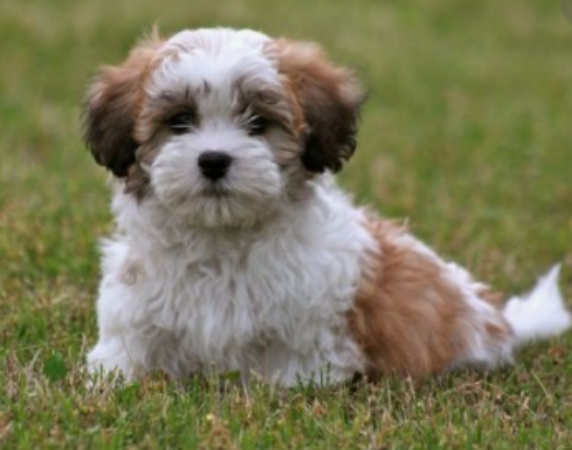
1. What should I feed my puppy when I first take it home?
Typically, a puppy is ready to move into a home about eight weeks of age. Find out what solid food it has been eating and its feeding schedule. Keep to the same routine for the first few weeks.
2. When can I change my Zuchon’s diet?
Once your puppy becomes used to its new home, you can start to feed it with different dog food. However, don’t make the change too suddenly.
Mix the new and old food at first, then slowly substitute more of the original for the former. Ask your veterinarian for recommendations.
Like humans, dogs need variety in their diets. Introduce a different flavour of the new dog food to your teddy bear.
3. Giving your teddy bear treats
Treats are marvellous teaching tools. They reinforce positive behaviour in dogs.
However, you should not over-feed your Zuchon. Since it is a small dog that weighs between 3 to 5 lbs, make sure that you pick a dog food suitable for its size. Feeding it with treats that are too big will disrupt its diet.
Many treats are low in nutrients. It’s best to choose those that are free of grains. Don’t feed your puppy with too many of them.
4. How often should I feed my teddy bear dog?
Puppies should eat three times daily for the first six months of their lives. Make sure that you keep yours on a consistent feeding schedule because doing otherwise will harm its digestive system.
Give it a big meal in the morning if you cannot feed it during lunch. The food should suffice till dinner-time.
5. How much should I feed my Zuchon?
It’s essential to feed a new puppy with the same amount of dog food it used to have before you took it home. Ask your breeder how much he or she used to feed it and the amount you should increase. A puppy typically eats about a third of a cup of dog food three times daily.
Don’t give your dog more food until it manages to clear its bowl within 15 minutes. Increase the amount by about 10% and observe how your dog reacts. Make adjustments accordingly.
6. Can I feed my dog anything other than dog food?
Puppies should stick to a dog food diet. Human food like raisins, garlic, onions, avocados, and macadamia nuts damage your dog’s gut. Feeding it from the dinner table teaches it to beg, which is embarrassing behaviour.
Zuchon Training
A cooperative, responsive dog is a joy. The teddy bear dog is intelligent and highly trainable. A few basic obedience commands will turn it into a dog everyone loves.
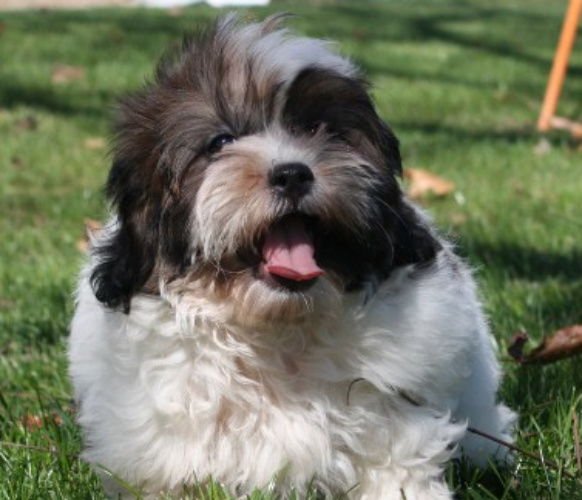
1. Sit
Every good dog knows how to sit. Here’s how to teach this command to a feisty teddy bear dog.
Have a treat ready. Move it over your dog’s nose then it’s muzzle. Keep it away from your dog at all times. As your dog’s head moves up, it’s behind should go down automatically. Give it the treat when this happens. Repeat this exercise several times.
When it’s familiar with the process, introduce the cue ‘sit.’Give the command before you move the treat from in front of its nose to the back of its head. Once the dog responds automatically, give it treats on occasion.
2. Leave it
An excited dog may ingest food when it’s outdoors. You may also want to prevent it from chewing. The ‘leave it’ instruction is useful in these situations.
Sit facing your dog, and have a treat between your thumb and index finger. Put your palm facing up. Show it to your dog.
Your dog will try to grab it from your hand. When it does, say ‘leave it’ and close your palm. Put it facing down.
Observe your dog’s reaction. It will probably stare at your hand. The minute it stops doing so, praise it and give it the treat.
You want your dog to respond to the ‘leave it’ instruction in all situations. Show the dog another treat. Put it on the floor and cover it with your hand. When it tries to get the treat, say ‘leave it’.
Watch for another break in attention. When your dog finally stops looking at the treat, praise and reward it.
3. Stay
Your dog needs to respond to this instruction when you’re walking on a busy road. You will also want to prevent it from jumping up on your guests. Your dog must first know the sit command.
Find a place where there are no distractions. Your dog should find it familiar. Make sure that it’s focused on you. Look it in the eye, and show it a treat. Ask it to sit.
If it remains sitting for some time, give it the treat. Repeat this process, making it sit for longer each time.
When it can hold its position for some time, say ‘stay’. When it moves, hold up your palm and say ‘stop’. Repeat this until your dog stays where it is for some time.
Altogether, the gentle teddy bear, with its loving disposition, will make an excellent companion. Proper grooming and nutrition will keep it in good health. It will be a responsive pet with consistent training.

Wow,
Thank you for this article. My daughter’s ZuChon, Daisy, makes a lot more sense now… Lol.
I was thinking Red Bull or Espresso was a better choice in names… Lol. That’s just her nature though.
She LOVES playing fetch, and she’s FAST getting the ball also. I worried that hybrids would suffer diminished capacity but you say the cross breeding makes her stronger… that’s great news, many years of play left in her.
We consider her our pet granddaughter until human grands come around. ✌